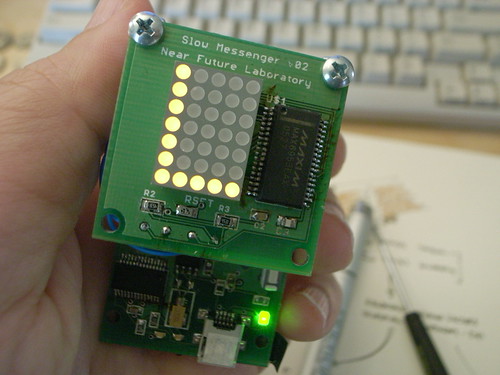
Finally, something to show for this “Slow Messenger” project, a playful interface for instant messaging. I’ve gotten all the hardware bits cobbled together and most of the firmware. Now I’m working on learning how to tie in AOL Instant Messenger so that messages can be delivered to the device. Fortunately (I think) AOL has opened their API somewhat. You get some sort of key and then can create your own IM applications based on their protocol and network. I don’t know how well this works, but I suspect if it works well-enough, a preposterous projects like this should be able to make good use of it.
I found one little unexpected design glitch — the LED driver (MAX6953) and the EEPROM I’m using (AT24C1024) have the exact same ‘default’ I2C address (0x50). I stumbled across this while trying to debug why the EEPROM didn’t seem to work, even after an electrical test and crap. You can typically hard-wire the chip to take on one of another possible addresses. On the AT241024 you just wire the A1 pin to either GND or VCC and set the A1 bit of the device address either low or high. The MAX6953 has a similar deal, only a larger matrix of possible different addresses, probably because the chip will typically be found in systems with lots of MAX6953s ganged together to drive large LED displays. In my case, it’ll be easier to make some small hardware changes to the Slow Messenger display board than it’ll be to change the AT241024, which is on a generic Flavonoid board that I want to keep as identical as possible to the other one’s to make managing the firmware easier.
Strange, but I thought that I got closer to having the real-deal I’d understand more about why I’ve committed so much time to doing it. But, I’m no where near understanding why I’m doing it or what it means. This may be beyond the near future and somewhere from another planet.
I heard someone confuse the Near Future Laboratory with corporate R&D. Like, essentially assuming that what I was doing was stuff just around the bend that someone at some corporate lab or product design operation is probably better suited to develop. Whatev. The Near Future Laboratory is the other near future — the one no one in a corporate lab would really think about because the demands of commerce minimize risk, don’t even scratch their heads if the perceived market is too small, and only think about what can be realized to help make next year’s earnings look good. Just to clarify.
Technorati Tags: Near Future Laboratory, slowest instant messenger
One thought on “The World's Slowest Instant Messenger, Part II”
Comments are closed.